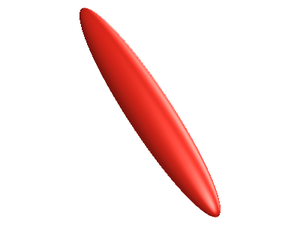Hard ellipsoid model: Difference between revisions
Jump to navigation
Jump to search
Carl McBride (talk | contribs) No edit summary |
Carl McBride (talk | contribs) No edit summary |
||
| Line 11: | Line 11: | ||
*[http://dx.doi.org/:10.1016/0021-9991(85)90171-8 John W. Perram and M. S. Wertheim "Statistical mechanics of hard ellipsoids. I. Overlap algorithm and the contact function", Journal of Computational Physics '''58''' pp. 409-416 (1985)] | *[http://dx.doi.org/:10.1016/0021-9991(85)90171-8 John W. Perram and M. S. Wertheim "Statistical mechanics of hard ellipsoids. I. Overlap algorithm and the contact function", Journal of Computational Physics '''58''' pp. 409-416 (1985)] | ||
==Geometric properties== | ==Geometric properties== | ||
The mean radius of curvature is given by ( | The mean radius of curvature is given by (Refs. 2 and 3) | ||
:<math>R= \frac{a}{2} \left[ \sqrt{\frac{1+\epsilon_b}{1+\epsilon_c}} + \sqrt \epsilon_c \left\{ \frac{1}{\epsilon_c} F(\varphi , k_1) + E(\varphi,k_1) \right\}\right], | :<math>R= \frac{a}{2} \left[ \sqrt{\frac{1+\epsilon_b}{1+\epsilon_c}} + \sqrt \epsilon_c \left\{ \frac{1}{\epsilon_c} F(\varphi , k_1) + E(\varphi,k_1) \right\}\right], | ||
| Line 43: | Line 43: | ||
:<math>V = \frac{4 \pi}{3}abc.</math> | :<math>V = \frac{4 \pi}{3}abc.</math> | ||
[http://www.qft.iqfr.csic.es/personal/carl/SR_B2_B3_ellipsoids.nb Mathematica notebook file for calculating the surface area and mean radius of curvature of an ellipsoid] | |||
==See also== | ==See also== | ||
*[[Hard ellipsoid equation of state]] | *[[Hard ellipsoid equation of state]] | ||
| Line 49: | Line 49: | ||
#[http://dx.doi.org/10.1016/j.fluid.2007.03.026 Carl McBride and Enrique Lomba "Hard biaxial ellipsoids revisited: Numerical results", Fluid Phase Equilibria '''255''' pp. 37-45 (2007)] | #[http://dx.doi.org/10.1016/j.fluid.2007.03.026 Carl McBride and Enrique Lomba "Hard biaxial ellipsoids revisited: Numerical results", Fluid Phase Equilibria '''255''' pp. 37-45 (2007)] | ||
#[http://dx.doi.org/10.1063/1.472110 G. S. Singh and B. Kumar "Geometry of hard ellipsoidal fluids and their virial coefficients", Journal of Chemical Physics '''105''' pp. 2429-2435 (1996)] | #[http://dx.doi.org/10.1063/1.472110 G. S. Singh and B. Kumar "Geometry of hard ellipsoidal fluids and their virial coefficients", Journal of Chemical Physics '''105''' pp. 2429-2435 (1996)] | ||
#[http://dx.doi.org/10.1006/aphy.2001.6166 G. S. Singh and B. Kumar "Molecular Fluids and Liquid Crystals in Convex-Body Coordinate Systems", Annals of Physics '''294''' pp. 24-47 (2001)] | |||
[[Category: Models]] | [[Category: Models]] | ||
Revision as of 13:17, 29 June 2007

Interaction Potential
The general ellipsoid, also called a triaxial ellipsoid, is a quadratic surface which is given in Cartesian coordinates by
where , and define the lengths of the axis.
Overlap algorithm
The most widely used overlap algorithm is that of Perram and Wertheim:
Geometric properties
The mean radius of curvature is given by (Refs. 2 and 3)
and the surface area is given by
where is an elliptic integral of the first kind and is an elliptic integral of the second kind, with the amplitude being
and the moduli
and
where the anisotropy parameters, and , are
and
The volume of the ellipsoid is given by the well known
See also
References
- Carl McBride and Enrique Lomba "Hard biaxial ellipsoids revisited: Numerical results", Fluid Phase Equilibria 255 pp. 37-45 (2007)
- G. S. Singh and B. Kumar "Geometry of hard ellipsoidal fluids and their virial coefficients", Journal of Chemical Physics 105 pp. 2429-2435 (1996)
- G. S. Singh and B. Kumar "Molecular Fluids and Liquid Crystals in Convex-Body Coordinate Systems", Annals of Physics 294 pp. 24-47 (2001)




![{\displaystyle R={\frac {a}{2}}\left[{\sqrt {\frac {1+\epsilon _{b}}{1+\epsilon _{c}}}}+{\sqrt {\epsilon }}_{c}\left\{{\frac {1}{\epsilon _{c}}}F(\varphi ,k_{1})+E(\varphi ,k_{1})\right\}\right],}](https://wikimedia.org/api/rest_v1/media/math/render/svg/4e881e50476a138c1b82d0eff3fa835b1212160d)
![{\displaystyle S=2\pi a^{2}\left[1+{\sqrt {\epsilon _{c}(1+\epsilon _{b})}}\left\{{\frac {1}{\epsilon _{c}}}F(\varphi ,k_{2})+E(\varphi ,k_{2})\right\}\right],}](https://wikimedia.org/api/rest_v1/media/math/render/svg/0a0370210651aa0d817cf6bd9f11fc9898f4a23b)









